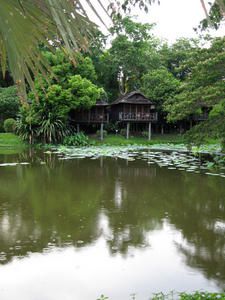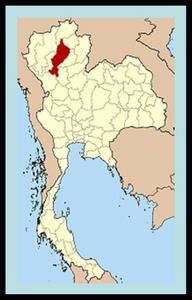Province de Lampang
Rédigé par Chang Aucun commentaire

Province de Lampang Province de Lampang La Province de Lampang se situe dans la région Nord de la Thaïlande. On peut rescenser de nombreux […]
Province de Lampang

Province de Lampang
La Province de Lampang se situe dans la région Nord de la Thaïlande. On peut rescenser de nombreux elephants a Lampang...
Lampang (Thai ลำปาง) is one of the northern provinces (changwat) of Thailand. Neighboring provinces are (from north clockwise) Chiang Rai, Phayao, Phrae, Sukhothai, Tak, Lamphun and Chiang Mai. The old name of Lampang is Khelang Nakhon.
Province de Lampang - Geography
Lampang is located in the broad river valley of the Wang River, surrounded by mountain chains. In the Mae Mo district lignite is found and mined in open pits. To the north of the province is the 1697 m high Doi Luang.
Within the province are the national parks Tham Pha Thai, Chae Son, Doi Khun Than, as well as the Huay Tak Teak Biosphere Reserve.
Province de Lampang - Economy
Lampang is famous for the production of ceramic goods and mining operations. A great deal of ball clay, china stone, and lignite are extracted from the surrounding mountains.
There are more than 200 ceramic factories in and around Mueang Lampang. Most of ceramic factories are small to medium size operations mainly producing novelties (plant pots, dolls), tablewares, and building materials (tiles, railings), etc.
The largest power plant in Thailand is located in Mae Mo district near the lignite mining area. The plant uses the abundant lignite as fuel. The largest concrete plant is also situated north of Mueang Lampang. This is also powered by the lignite. Limestone is another abundant mineral mined in Lampang.
Agricultural products that are famous for this province are rice and pineapples.
Province de Lampang - History
Starting in the 7th century Lampang was part of the Dvaravati period Haripunchai kingdom of the Mon. In the 11th century the Khmer empire occupied the Lampang area, but it was King Mengrai of Lannathai who incorporated the complete Haripunchai kingdom into his kingdom in 1292. Lampang or Nakhon Lampang or Lakhon, was under the Burmese rule after the fall of Lannathai Kingdom from the sixteenth century to eighteenth century. During the uprising against Burmese rule by Siam's new kings in the late eighteenth century, a Lampang's local leader became Siam's ally. After the victory, the leader was named to be the ruler of Chiangmai, the former center of Lannathai, while his relative ruled Lampang. The city continues to be one of the most important economic and political centers in the north. Lampang was announced as a province in Thailand in 1892.
Province de Lampang - Symbols
The provincial seal shows a white rooster inside the entrance to the Phra That Lampang Luang temple. According to the local legend Buddha visited the province in his lifetime. The god Indra worried that the people would not get up by themselves to show respect to Buddha, and therefor woke them by transforming himself into a white rooster.
The provincial flower is the Heliconia (Heliconia sp.), and the provincial tree is the Indian Elm (Holoptelea integrifolia). According to the legend during Buddha's visit this tree was planted in the temple.
Province de Lampang - Administrative divisions
The province is subdivided in 13 districts (amphoe). These are further subdivided into 100 communes (tambon) and 855 villages (muban).
Mueang Lampang
Mae Mo
Ko Kha
Soem Ngam
Ngao
Chae Hom
Wang Nuea
Thoen
Mae Phrik
Mae Tha
Sop Prap
Hang Chat
Mueang Pan
Province de Lampang - Tourism
Sights
Kaeo Don Tao (วัดพระแก้วดอนเต้า) used to be the place where the Emerald Buddha was once enshrined (the same statue now installed in Bangkok). Interesting structures include the large Chedi containing the hair of the Lord Buddha, a Burmese-style Mondop, an ancient Viharn and a museum exhibiting ancient relics of the Lanna era.
To the west of town is Wat Si Rong Mueang (วัดศรีรองเมือง), a Burmese temple built in 1905 during the time when Lampang was the commercial and forestry centre. Major architectural works include the Viharn made of wood with several overlapping gables in the Burmese style.
Built during the reign of King Rama IV by Burmese, Wat Pa Fang (วัดป่าฝาง) has a large, glittering gold Chedi containing a Holy Relic brought over from Myanmar around 1906. The extensive Sala Kan Parian (preaching hall) is made entirely of wood with Burmese-style overlapping roofs.
Almost across Wat Pa Fang is Wat Chai Mongkhon (วัดไชยมงคล). The outstanding structure is the Kuti, monk's living quarters, which is a white cement building with Burmese-style wooden roof. Inside is housed a bronze Buddha statue of fine workmanship cast in Mandalay, Myanmar.
About 5 kilometres from town on the Lampang-Chae Hom road is Wat Chedi Sao Lang (วัดเจดีย์ซาวหลัง). Cooled and shaded by large trees, the temple has twenty Chedis is its compound, each made in the combined Lanna-Burmese style. A Chiang Saen-style bronze Buddha statue is also enshrined here, commonly referred to as "Phra Chao Than Chai" by the local people.
Wat Phra That Mon Phaya Chae (วัดพระธาตุม่อนพระยาแช่). As it is situated on a hillside, it affords a clear view of Lampang. Its most outstanding feature is the long stair leading to the Chedi enshrining a Holy Relic.
Wat Phra That Sadet (วัดพระธาตุเสด็จ) One of Lampang's major sites, it is believed to have been built by Queen Chamthevi some 500 years ago.
Kiu Lom Dam (เขื่อนกิ่วลม) is about 38 kilometres from town.
Thanon Talat Kao or Thanon Talat Chin or Thanon Khon Doen “Kat Kongta” (ถนนตลาดเก่า หรือ ถนนตลาดจีน หรือ ถนนคนเดิน “กาดกองต้า”) is a market next to the pier. In the past, it was a prosperous market. The buildings on both sides of the river bank have a combination of European, Chinese and Burmese architectural styles. Thanon Khon Doen, “Kat Kongta” presents a local lifestyle of the Kat Kongta community.
Wat Phra That Lampang Luang (วัดพระธาตุลำปางหลวง), a paradigm of temple building of Lanna. The temple itself is prominently sited on a hillock surrounded by walls. The entrance arches, called Pratu Khong (ประตูโขง), is adorned with fine plaster designs. The wall-less main Viharn houses a bronze Buddha statue called the Phra Chao Lan Thong (พระเจ้าล้านทอง).
Wat Phra That Chom Ping (วัดพระธาตุจอมปิง) The amazing aspect of the temple is the natural-coloured reflection of the Phrathat passing through the hole of the window and appearing on the floor inside the Phra Ubosot all the time when there is light, both during the day and at night (see Camera obscura).
Thai Elephants Conservation Centre (ศูนย์อนุรักษ์ช้างไทย) It is the only facility in the world devoted to the training of elephants for timber work using these pachyderms as laborers. There are performances and training demonstrations.
The Khun Than mountain range of the Doi Khun Than National Park (อุทยานแห่งชาติดอยขุนตาล) forms a natural boundary between Lamphun and Lampang provinces. The mountain has both virgin jungle and pinery.
Chao Pho Pratu Pha Shrine (ศาลเจ้าพ่อประตูผา) Legend has it that Chao Pho Pratu Pha was a great warrior of the Lampang ruler. He once fought Burmese invaders to block their advance at Pratu Pha and died fighting with his two swords still in his hands and his body still leaning against the hillside. To honour the brave warrior, the people build the shrine which has since become a sacred and revered place of worship.
Tham Pha Thai National Park (อุทยานแห่งชาติถ้ำผาไท) is located between Mueang Lampang and Ngao districts just off the main highway at km.665-666, some 60 kilometres from the provincial town.
Ban Chang Luang (บ้านจ้างหลวง หรือ ศูนย์ศิลปะชุมชนเมืองงาว) is a facility established by Khru Kam-aye Dejduangta (ครูคำอ้าย เดชดวงตา). It has an extensive collection of wood-carvings made by Kru Kam-aye himself and serves as a school to train those intending to become artisans and to provide occupations for the local people.
A major place for relaxation in Lampang is the Chae Son National Park (อุทยานแห่งชาติแจ้ซ้อน) which is located in Mueang Pan district area having a lush forested and mountainous region with a 73 Celsius hot spring over rocky terrain, providing a misty and picturesque scene particularly in the morning.
Namtok Wang Kaeo (น้ำตกวังแก้ว) is Lampang's largest waterfall.
Local Products
Hand-made Cotton (ผ้าทอมือ) comes in different patterns designed by different villages.
Wood-carving (ไม้แกะสลัก) is a major industry at Tambon Na Khrua of Mae Tha district which is about 25 kilometres from the provincial town. Most of the local people make their living by producing wooden figures of animals in various sizes. It has been a cottage industry in this locality for generations.
Terra-cotta or Ceramics (เซรามิก) produced in Lampang are of the best quality in Thailand. The indigenous clay, added by the local craftsmanship, has helped to make Lampang the centre of such products, with scores of factories and shops dealing in this beautiful craft.
Sa Paper (กระดาษสา) is a fine product made from a type of soft wood. The process is purely traditional and the major producing center is the village of Ban Nam Thong. The Sa is mainly made into parasols, lampshades, decorative flowers and other souvenir items.
Province de Lampang - Culture
Festivals
Luang Wiang Lakhon Fair (งานหลวงเวียงละคอน) is held just prior to the annual Loi Krathong event around Wat Phra Kaeo Don Tao and Wat Phra That Lampang Luang, featuring Lampang's own historical backgrounds and long-established customs and traditions. A Khrua Than procession is organized with local people dressed in native attires carrying various traditional household appliances, some of which are of ancient vintage.
Khantok Chang Fair (งานขันโตกช้าง หรือ สะโตกช้าง) is organised on the first Friday-Saturday period of February each year at the Thai Elephant conservation Centre. There is an elephant show and the pachyderms are feasted with their popular fruits and vegetables which are placed on the Tok, a traditional food tray of the Lanna people.
Lampang Trains and Horse Carriages Day (งานวันรถไฟรถม้าลำปาง) is organized at the Nakhon Lampang Railway Station at the beginning of April to commemorate the first royal train that arrived to the station 1 April, 1916. In the event, there will be an exhibition and Kat Mua market, where the participants will dress up in the traditional style of costume of some 80 years ago, when the horse carriage was first used in Lampang. The carriage service is also provided in the event.
Salung Luang Procession and Songkran Festival (งานแห่สลุงหลวงและสงกรานต์) is the unique Songkran festival of Lampang, organized during 12-14 April every year. On the 12 April, the Salung Luang procession will be beautifully decorated (Salung means a water bowl and Luang means large). The participants in the parade will dress up in the ancient Lanna style and carry a giant silver bowl around the city to receive lustral water soaked with turmeric and acacia from the people to be poured onto the Phra Kaeo Don Tao, the revered Buddha image of the town enshrined at Wat Phrathat Lampang Luang. Then, during 13-14 April every year, there will be a merit making ceremony at the temple, sand pagoda making, ceremony of pouring water onto the elderly, splashing of water, fairs and various forms of entertainment.
Province de Lampang - Cartographie

Province de Lampang
